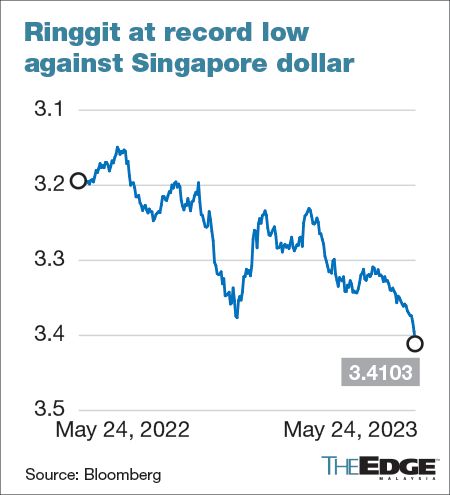Ringgit Hits Fresh Low Against Singapore Dollar at 3.4103
edgeinvest
Publish date: Thu, 25 May 2023, 08:34 AM
KUALA LUMPUR (May 24): The ringgit slipped to another new low of 3.4103 against the Singapore dollar (SGD) on Wednesday (May 24).
The ringgit/SGD exchange rate, which has depreciated 3.62% year to date, had previously fallen to 3.3764 on August 11, 2022.
This is not surprising as the Monetary Authority of Singapore (MAS) has adopted a more aggressive monetary policy stance to counter rising inflationary pressures by making changes to the slope of the currency basket, which economists believe has led to an appreciation of SGD.
"The ringgit has weakened against SGD because investors have confidence in the Singaporean economy, which is supported by its ‘AAA’ credit rating and substantial foreign exchange reserves," Kenanga Research economist Afiq Asyraf Syazwan Abd Rahim told The Edge.
Regardless, the performance of the SGD against the ringgit is very much tied to the performance of the US dollar.
“The SGD is managed within an undisclosed bandwidth versus the US dollar. Therefore, a strengthening of the US dollar will see a subsequent strengthening of the Singapore dollar”, said MIDF head of research Imran Yassin Md Yusof.
On Wednesday, the ringgit depreciated to 4.5935 against the US dollar. Economists contacted by The Edge project the ringgit to trade between 4.11 and 4.35 against the greenback by the end of this year.
US debt ceiling concern
The weakness in the ringgit performance has been more intense as investors remain cautious on higher risk aversion due to concerns that the US is still struggling to reach an agreement to raise its debt ceiling. Although this is not a new issue, failure to do so could lead to a default in debt obligation.
Dr Mohd Afzanizam Abdul Rashid, chief economist and head of social finance at Bank Muamalat Malaysia Bhd, said the debt crisis in the US in 2011 indicated that it could wreak havoc on the financial market, especially when the US Congress decided to leave raising the debt ceiling to the last minute, resulting in a sovereign rating downgrade by Standard & Poor (S&P) from “AAA” to “AA +”.
“Given the current polarisation in US politics, the decision could be stalled to the very last minute, which worries the market. So the risk-off could prevail leading to more interest in safe haven like the US dollar and by extension, ringgit could depreciate,” he said.
The US last raised the debt ceiling on Dec 16, 2021 to its current level of US$31.4 trillion (RM142.2 trillion), which it hit on Jan 19 this year. Last Sunday, US Treasury Secretary Janet Yellen said June 1 remains a "hard deadline" for raising the debt limit, with the odds quite low that the government will collect enough revenue to bridge to June 15, when more tax receipts are due, Reuters reported.
If a deal on the debt ceiling issue is not reached soon, it is likely that the ringgit may breach the psychological threshold of 4.6 in the next few days as the US financial markets experience further dislocation, Afiq Asyraf Syazwan highlighted.
“However, I anticipate that a deal will be reached before the US default on its debt, leading to a recovery of the ringgit below the 4.5 level,” he elaborated.
And if the US Federal Reserve (US Fed) pauses the interest rate hike in its upcoming meeting next month — after the 11th time hike in a row — the local currency could strengthen further to close to the 4.40 level, Afiq Asyraf added.
Earlier this month, Bank Negara Malaysia made a surprise move by raising the overnight policy rate by 25 basis points to 3% — the first hike since November last year after raising the benchmark lending rate by 100 basis points since the pandemic outbreak.
Waning China optimism
Apart from that, the economists said, waning optimism over China’s post-opening Covid-19 recovery may continue to weigh on the performance of the ringgit in the upcoming months. This is because the Chinese yuan and the ringgit are closely related.
For perspective, China has been Malaysia’s largest trading partner since 2009. The value of trade between Malaysia and China in 2022 was about 17.1% of Malaysia’s total global trade worth RM2.8 trillion.
The Chinese government has set a modest target for economic growth of around 5% for 2023. In the first quarter this year, its economy expanded at a faster pace of 4.5% year-on-year, thanks to the end of the Covid-19 restrictions in December 2022.
Source: TheEdge - 25 May 2023
More articles on CEO Morning Brief
Created by edgeinvest | Apr 19, 2024
Created by edgeinvest | Apr 19, 2024
Created by edgeinvest | Apr 19, 2024
Created by edgeinvest | Apr 19, 2024

















